Online Course
NRSG 780 - Health Promotion and Population Health
Module 3: Epidemiology
Establishing Priorities
Despite the power of epidemiological evidence, public health agencies and organizations do not always use epidemiology, which is considered the core science of public health, as the basis for decision-making and priority setting.
Priorities are also based on non-scientific grounds that include:
- Incremental shifts from previous priorities
- Personal preferences of new agency decision-maker(s)
- Executive decisions from outside the agency
- Legislative demands
- Epidemiologic evidence
Each of these approaches has advantages and disadvantages
- Incremental shifts from previous priorities
- Advantage: few object to these
- Disadvantage: rarely scientifically grounded
- Personal preferences of new agency decision-maker(s)
- Advantage: presents opportunities for change
- Disadvantage: often not scientifically grounded
- Executive decisions from outside the agency
- Advantage: presents opportunities for change
- Disadvantage: usually politically grounded
- Legislative demands
- Advantage: thinking outside the “box”
- Disadvantage: may not be scientifically grounded
- Epidemiologic evidence
- Advantage: decisions have a sound scientific foundation
- Disadvantage: may be politically unpopular
Exercise
Click on the links below to compare the initial news release by the CDC in the wake of Hurricane Katrina with a report issued by The Lancet on the same day.
Question: How do the reports compare?
Update on CDC's Response to Hurricane Katrina

The CDC’s public health response to Hurricane Katrina continues to be intense. Early disease and injury assessments have shown no unexpected health concerns. Vigilant disease, environmental and injury surveillance continues.
Public health professionals remain concerned about mosquito control and health risks posed by other pests such as rodents in some areas affected by Hurricane Katrina.
Katrina Reveals Fatal Weaknesses in U.S. Public Health
One of the most shocking aspects of the crisis caused by Hurricane Katrina has been the poor emergency response. But the failure is no real surprise, says Samuel Loewenberg in a World Report. This week's lead Editorial states: "for the response to have been so sparse and so late that thousands of people had to endure 6 parched and hungry days in the drowning city, the public-health authorities must have got things very badly wrong…
Answer: Note how the CDC’s initial reporting of the response to Hurricane Katrina did not raise the level of concern that was articulated by British health professionals in The Lancet. Start thinking about how:
- health departments establish priorities,
- public health is often referred to as what you don’t see, and competing avenues for funding influence public capacity to address crises.
Using Epidemiology to Establish Priorities
Magnitude of the Problem
When priorities are based on epidemiology, a key element is the magnitude of the problem as measured by:
- Mortality/morbidity rates
- Years of life lost
- Direct and indirect costs
If the focus is the leading causes of death, heavier emphasis has been placed on heart disease, cancer, chronic lower respiratory diseases, and accidents and less on infectious disease.However, with the emergence of COVID-19 renewed emphasis is being placed on infectious disease.
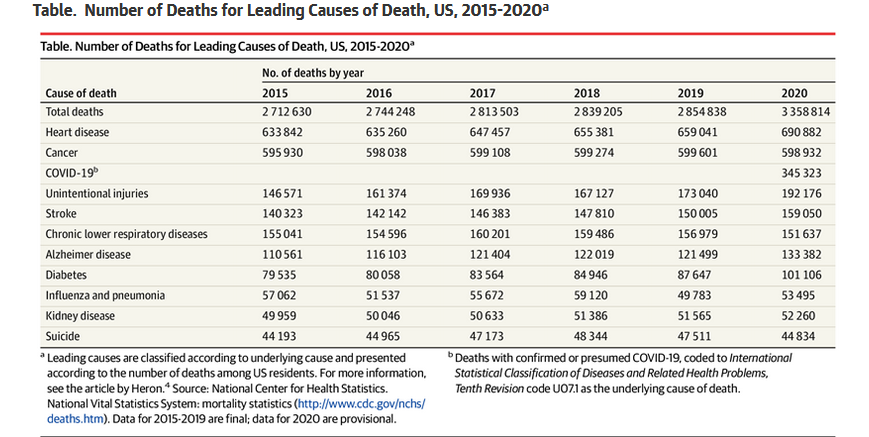
Source: https://jamanetwork.com/journals/jama/fullarticle/2778234 March 31, 2021
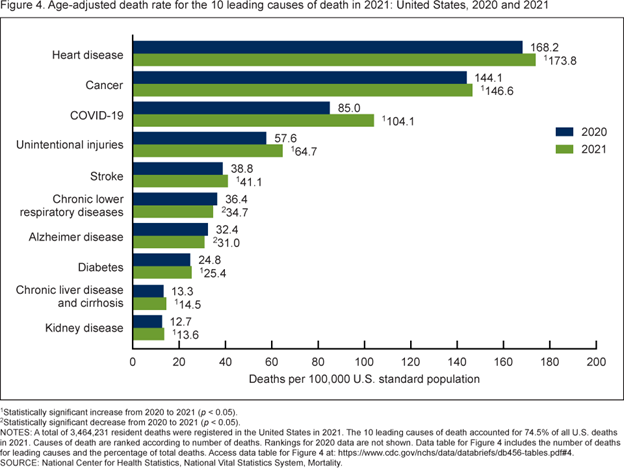
Source: NCHS Data Brief No. 456, December 2022
When we study our public health successes in terms of infectious and chronic diseases, from this chart, we can see how there truly has been a revolution in the conquering of infectious disease. We can also see that minimal success has been achieved in the chronic disease arena.
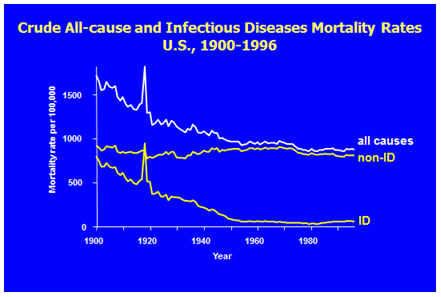
When we consider measuring the magnitude of the problem in terms of years of life lost before the age of 75, the greatest emphasis would shift to unintentional injuries, cancer, heart disease, and COVID.
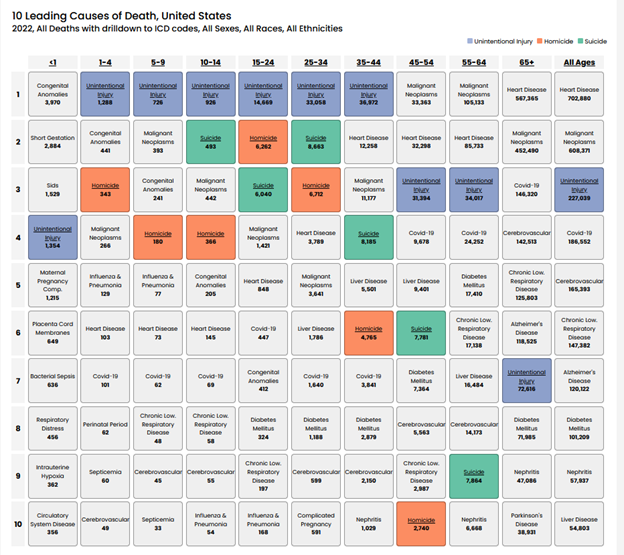
Source: WISQARS Data Visualization (cdc.gov)
When we revisit the contributions of various factors to premature mortality, addressing lifestyle interventions become a leading priority.
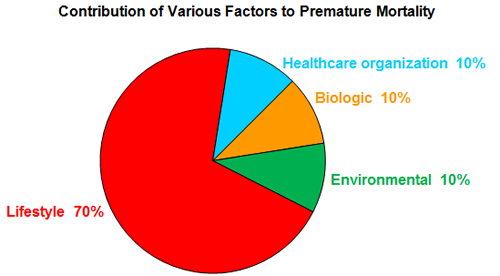
Population-based Strategies
The most successful large scale interventions that have resulted in significant increases in longevity and quality of life, like the Finland initiative, have moved beyond high risk strategies to population-based strategies:
- high risk strategies - focus on identifying the relatively small number of individuals who are at high risk in order to reduce their risk factor(s) and subsequent development of disease
- population-based strategies - focus on changing behavior in large numbers of people, most of whom have low or no risk at present, in order to prevent the development of risk factors and disease
As we look at heart disease mortality in relation to cholesterol levels we see that significant mortality occurs in the mid-range. Only focusing on those who are highest risk would miss a considerable part of the population that is at risk as well.
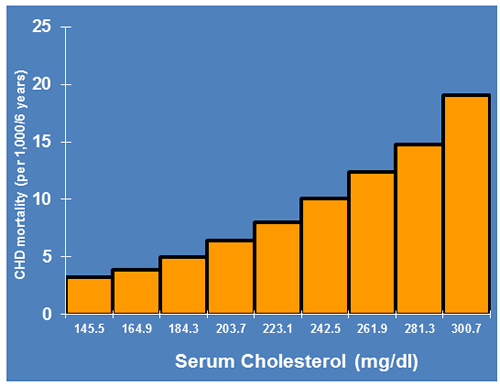
This graph shows the distribution of cholesterol levels in the population and again demonstrates that if prevention strategies are approached from a whole population perspective, the impact on morality will be much more significant, than if only those at highest risk are targeted.
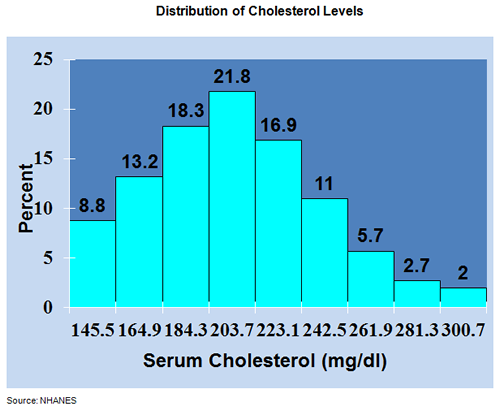
Epidemiologically-Based Criteria
When health departments or agencies establish priorities based on the epidemiological evidence they utilize the following criteria:
- Magnitude of the problem
- Mortality/morbidity rates
- Number of people effected
- Extent to which modifiable causes of the problem had been identified
- Extent to which interventions could reduce these causes and thereby reduce the magnitude of the problem
- Cost of the program relative to accomplishments
- Whether the program set rigorous goals and objectives and accomplished them
Summary
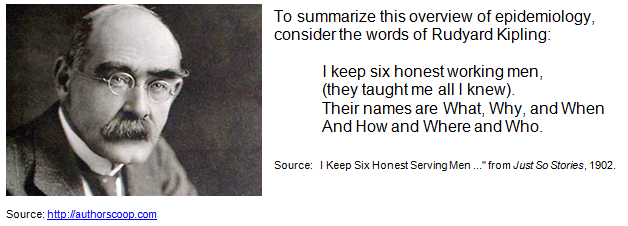
Putting in All Together
- The different types of epidemiologic studies each have strengths and weaknesses, but randomized clinical trials represent the gold standard.
- Epidemiology provides the scientific tools for acquiring high-quality data and for assessing the quality of others’ data.
- Epidemiologic principles should serve as the foundation for priority setting, both in public health and clinical practice.
- Data should be the driving forces for scientific policy and decision-making, although often they are not.
- Critically reading and keeping up with the literature is crucial to maintaining both clinical and policy-making skills.
This website is maintained by the University of Maryland School of Nursing (UMSON) Office of Learning Technologies. The UMSON logo and all other contents of this website are the sole property of UMSON and may not be used for any purpose without prior written consent. Links to other websites do not constitute or imply an endorsement of those sites, their content, or their products and services. Please send comments, corrections, and link improvements to nrsonline@umaryland.edu.